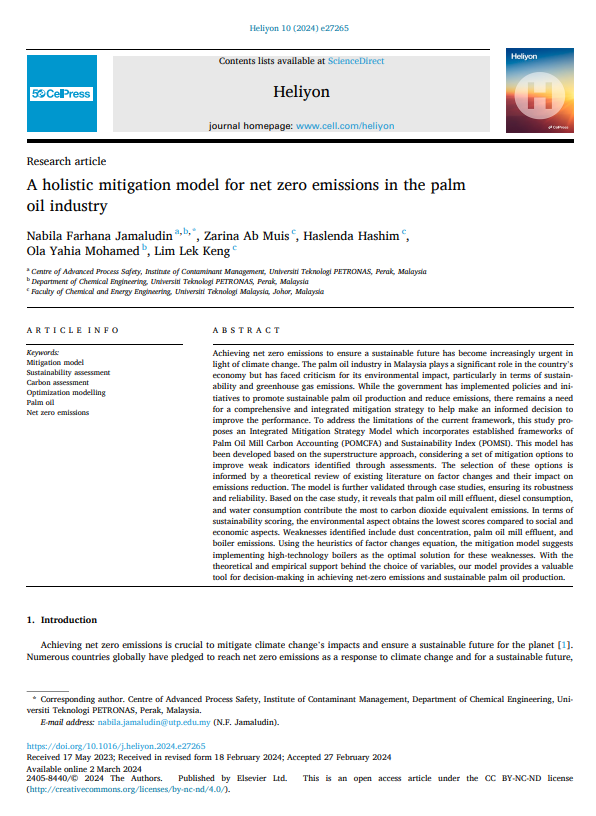
Keyword(s)
Author(s)
Nabila Farhana Jamaludin, Zarina Ab Muis, Haslenda Hashim, Ola Yahia Mohamed, Lim Lek Keng
Country(ies)
Publisher
Published Date
Access
DOI
(a) Centre of Advanced Process Safety, Institute of Contaminant Management, Universiti Teknologi PETRONAS, Perak, Malaysia
(b) Department of Chemical Engineering, Universiti Teknologi PETRONAS, Perak, Malaysia
(c) Faculty of Chemical and Energy Engineering, Universiti Teknologi Malaysia, Johor, Malaysia
Achieving net zero emissions to ensure a sustainable future has become increasingly urgent in light of climate change. The palm oil industry in Malaysia plays a significant role in the country’s economy but has faced criticism for its environmental impact, particularly in terms of sustainability and greenhouse gas emissions. While the government has implemented policies and initiatives to promote sustainable palm oil production and reduce emissions, there remains a need for a comprehensive and integrated mitigation strategy to help make an informed decision to improve the performance. To address the limitations of the current framework, this study proposes an Integrated Mitigation Strategy Model which incorporates established frameworks of Palm Oil Mill Carbon Accounting (POMCFA) and Sustainability Index (POMSI). This model has been developed based on the superstructure approach, considering a set of mitigation options to improve weak indicators identified through assessments. The selection of these options is informed by a theoretical review of existing literature on factor changes and their impact on emissions reduction. The model is further validated through case studies, ensuring its robustness and reliability. Based on the case study, it reveals that palm oil mill effluent, diesel consumption, and water consumption contribute the most to carbon dioxide equivalent emissions. In terms of sustainability scoring, the environmental aspect obtains the lowest scores compared to social and economic aspects. Weaknesses identified include dust concentration, palm oil mill effluent, and boiler emissions. Using the heuristics of factor changes equation, the mitigation model suggests implementing high-technology boilers as the optimal solution for these weaknesses. With the theoretical and empirical support behind the choice of variables, our model provides a valuable tool for decision-making in achieving net-zero emissions and sustainable palm oil production.